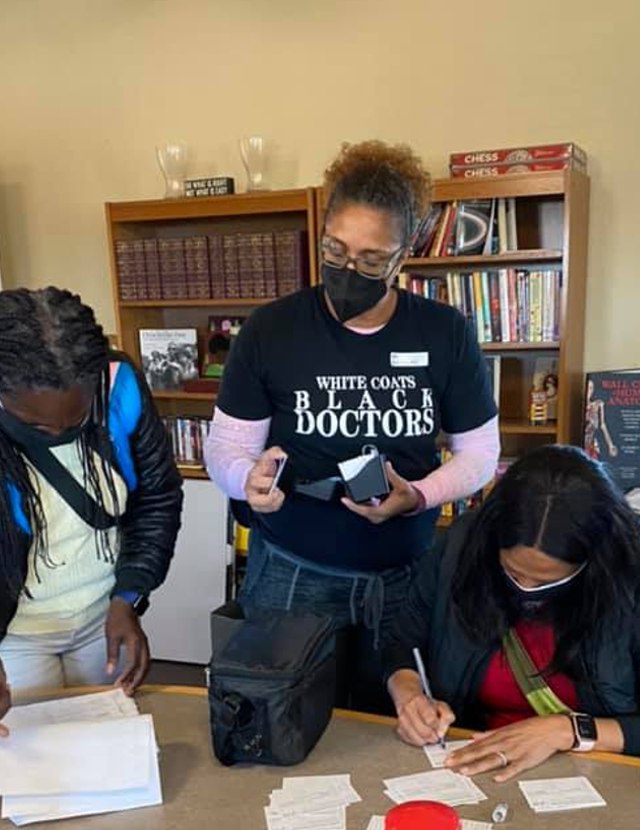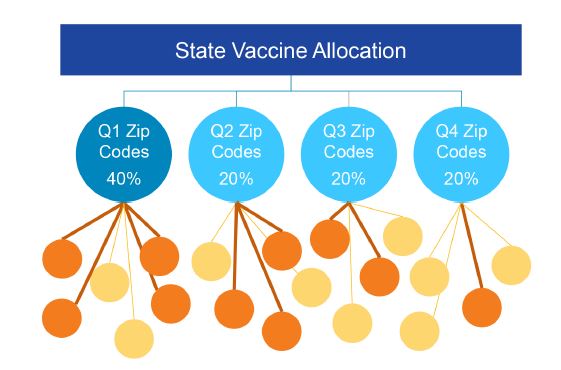HPI Helps Build Equity in California State COVID-19 Response, Serving as Model for Future Public Health Responses
Highlights

In 2020, the State of California selected the Healthy Places Index (HPI), a tool created by PHI's Public Health Alliance of Southern California, as a key resource to guide the state’s plan for an equitable and just COVID-19 response and recovery. HPI was used to target resources to the most impacted communities and support school reopening. A 2025 groundbreaking study from the California Department of Public Health and the University of California, San Francisco describes the innovation and success of HPI during the initial 18 months of the pandemic.
$272M funding directed to communities disproportionately impacted by COVID-19
$5M funding directed to 19 community-based organizations to implement Health Equity Pilots
800 vaccines per day directed to communities most disproportionately impacted by COVID-19
-
Focus Areas
Communicable Disease Prevention -
Issues
Population Health -
Expertise
Public Policy Development -
Strategic Initiatives
COVID-19, Vaccine Access & Equity
The intersection of race and place has been a significant driving factor in the impact of COVID-19. Communities of color and people living in communities with the least healthy living conditions experienced the highest rates of COVID-19 deaths in California.
In 2020, the State of California Department of Public Health (CDPH) selected the Healthy Places Index (HPI) as the tool that would guide the state’s plan for an equitable and just COVID-19 response and recovery. Created by PHI’s Public Health Alliance of Southern California, the HPI is a powerful data, mapping, and policy platform designed to identify opportunities to improve neighborhood health and help guide investments, programs, and policy changes to where they will have the strongest impact on life expectancy.
In 2025, a groundbreaking study from the California Department of Public Health and the University of California, San Francisco describes the innovative use of the HPI to address COVID-19 health disparities during the initial 18 months of the pandemic. Findings revealed that the least advantaged communities faced COVID-19 case rates up to six times higher and mortality rates up to five times higher than the most advantaged areas. These disparities narrowed over time though they were not eliminated. The study confirms that the state’s Blueprint for a Safer Economy was successful and underscores that data-driven, place-based strategies are an essential part of achieving health equity — not only in emergencies but as a foundation for all public health initiatives.

HPI was chosen by CDPH because of its granularity, the variation of geographic regions, comprehensive social determinants of health that were validated and linked to life expectancy at birth, and finally, paired with policy guides.Dr. Rohan Radhakrishna, Deputy Director, Office of Health Equity, California Department of Public Health
California used the HPI to create its Health Equity Metric and Vaccine Equity Metric, to help target resources to under-resourced and disproportionately impacted communities. The state also used HPI in monitoring and supporting school reopenings.
Using HPI to Develop a Health Equity Metric
The State of California used HPI as one of the key data sources in developing a first-in-the-nation Health Equity Metric (HEM). Utilizing HPI Census tract level data, the HEM compares COVID-19 rates between the lowest HPI quartile in each county with rates for the county as a whole. CDPH’s analysis found that HPI captured both race and place-based inequities and helped clarify that communities of color, as well as communities with the least healthy conditions, experienced the highest COVID-19 mortality rates.
The HEM was integrated into the State’s Blueprint for a Safer Economy reopening framework in September 2020, and was used to help guide reopening across California’s largest counties. The Metric was also used to prioritize the investment of resources to those communities facing the most severe inequities. As a result, the State was able to precisely target positive interventions and save many lives. For example, the HEM required local health departments to develop plans for allocating resources to communities with the lowest HPI scores.
As a result, approximately $272 million in federal COVID-19 funding was directed to these communities, including to community-based organizations representing Black and Latinx populations, and different smaller sub-groups of racial and ethnic populations such as Native Hawaiian and Pacific Islanders, who have seen some of the worst case and fatality rates. CDPH also directed $5 million in funding to 19 community-based organizations to implement Health Equity Pilots within these communities.

California implemented one of the largest at-scale equity-focused COVID-19 response and reopening policies in the US, which included at its core the use of an [Area-Based Socioeconomic Measures] called the California HPI. HPI was a valuable and actionable tool for tracking disparities, guiding policies, and allocating resources in a pandemic response for the most populous US state.Erica Pan, MD
Director and State Public Health Officer, California Department of Public Health
A Vaccine Equity Metric Based on HPI
The State chose HPI for use in the HEM after extensively analyzing and monitoring the equity impacts of COVID-19, and this successful use prompted the State to adapt the HPI for its Vaccine Equity Metric (VEM) in March 2021. While the VEM used HPI as its base, the State chose to apply the HPI at a zip code level, rather than at the census tract level where HPI is typically used. The State used the VEM in two ways:
First, when vaccines were in short supply in March 2021, the State used the VEM to prioritize allocation of 40% of vaccine doses to the lowest VEM quartile when vaccines were still in limited supply. According to Dr. Rohan Radhakrishna, Deputy Director of the CDPH Office of Health Equity, this meant 800 shots in arms per day to people living within the lowest quartile that otherwise would not have been prioritized.
The State also stratified vaccination rates by quartiles in order to monitor vaccine coverage and demand over time. Prioritizing vaccines by quartile resulted in more people getting vaccinated at a critical time during the pandemic.

School Reopening
The State also used HPI to monitor public schools that were open for in-person instruction, showing that fewer schools reopened in the lowest HPI quartile than in communities with healthier conditions, thus helping target reopening support where it was most needed.
Through these uses, HPI has helped to prioritize and marshal resources, including hundreds of millions of dollars in targeted investments, to communities with the least healthy conditions, and substantially decrease the loss of life across all racial/ethnic groups. HPI has also helped the State track and monitor trends over time and focus their policy and investment efforts on the communities most impacted by the pandemic. CDPH now highlights HPI as the “common language for addressing inequities” in its official presentations and briefings across the nation.
Work With Us
You change the world. We do the rest. Explore fiscal sponsorship at PHI.
Support Us
Together, we can accelerate our response to public health’s most critical issues.
Find Employment
Begin your career at the Public Health Institute.
